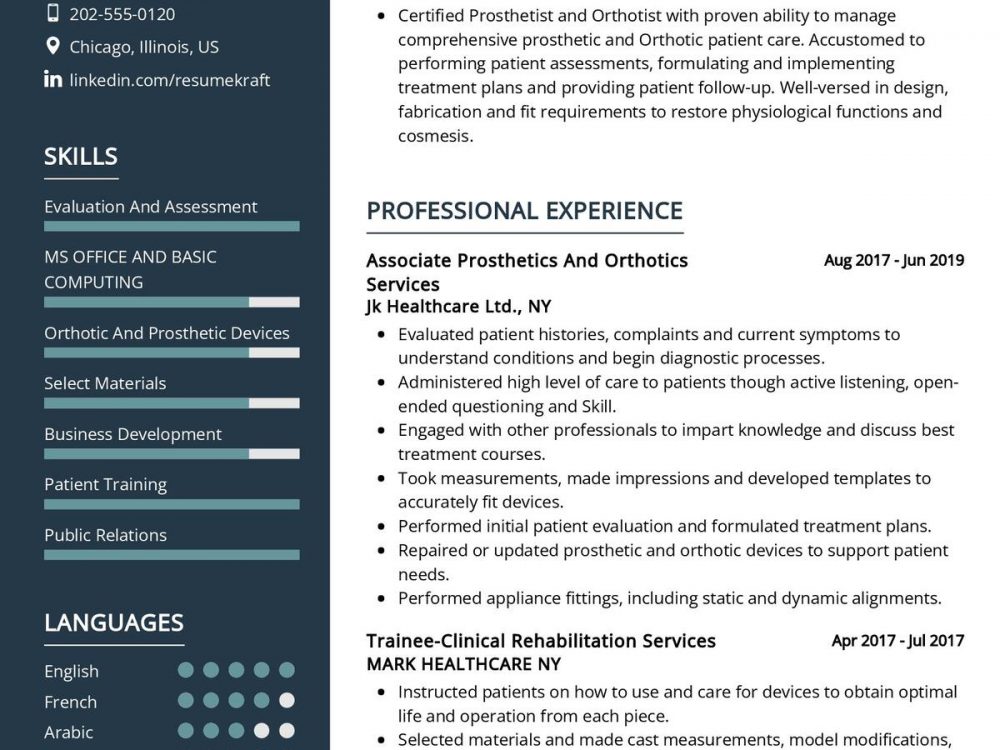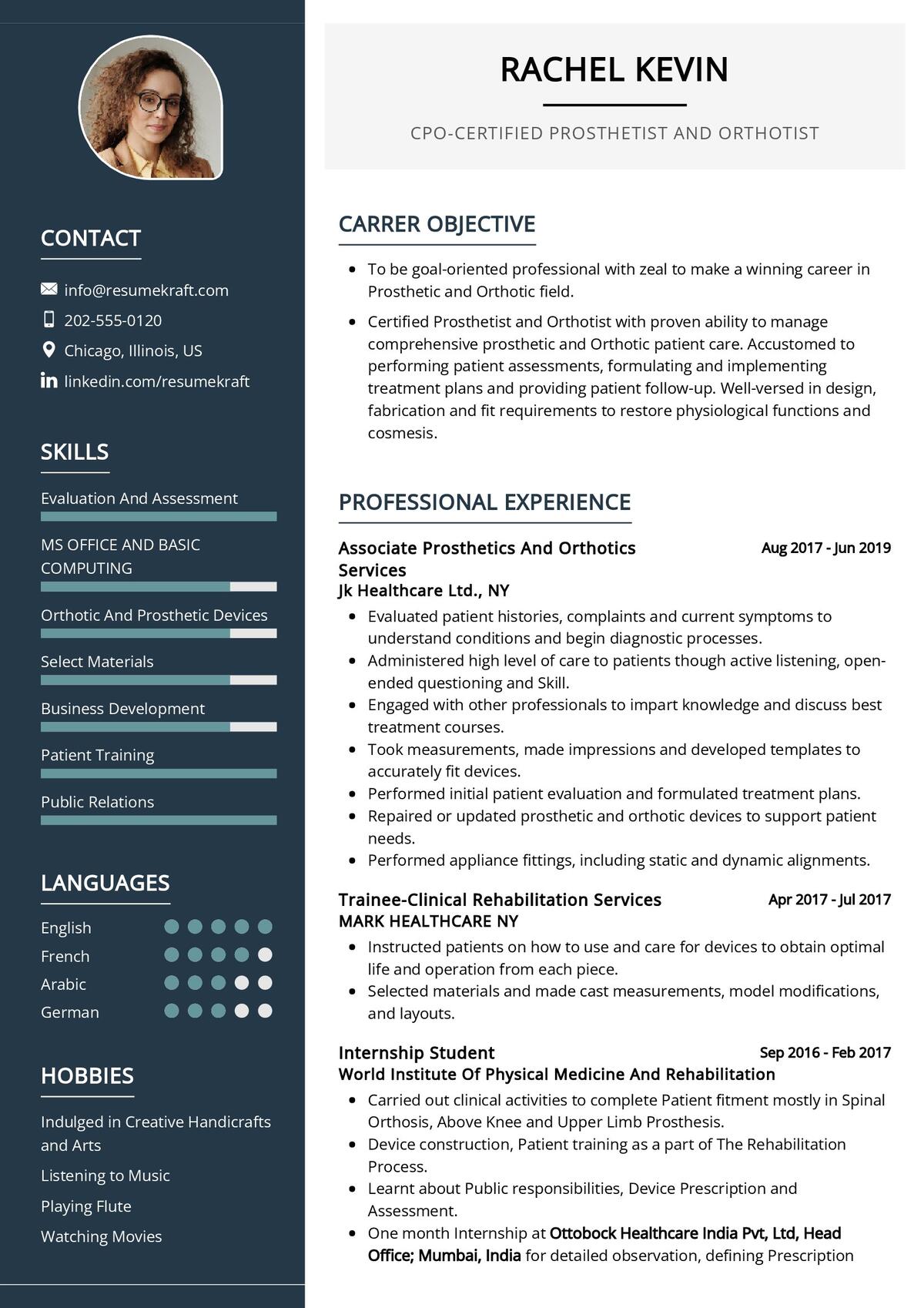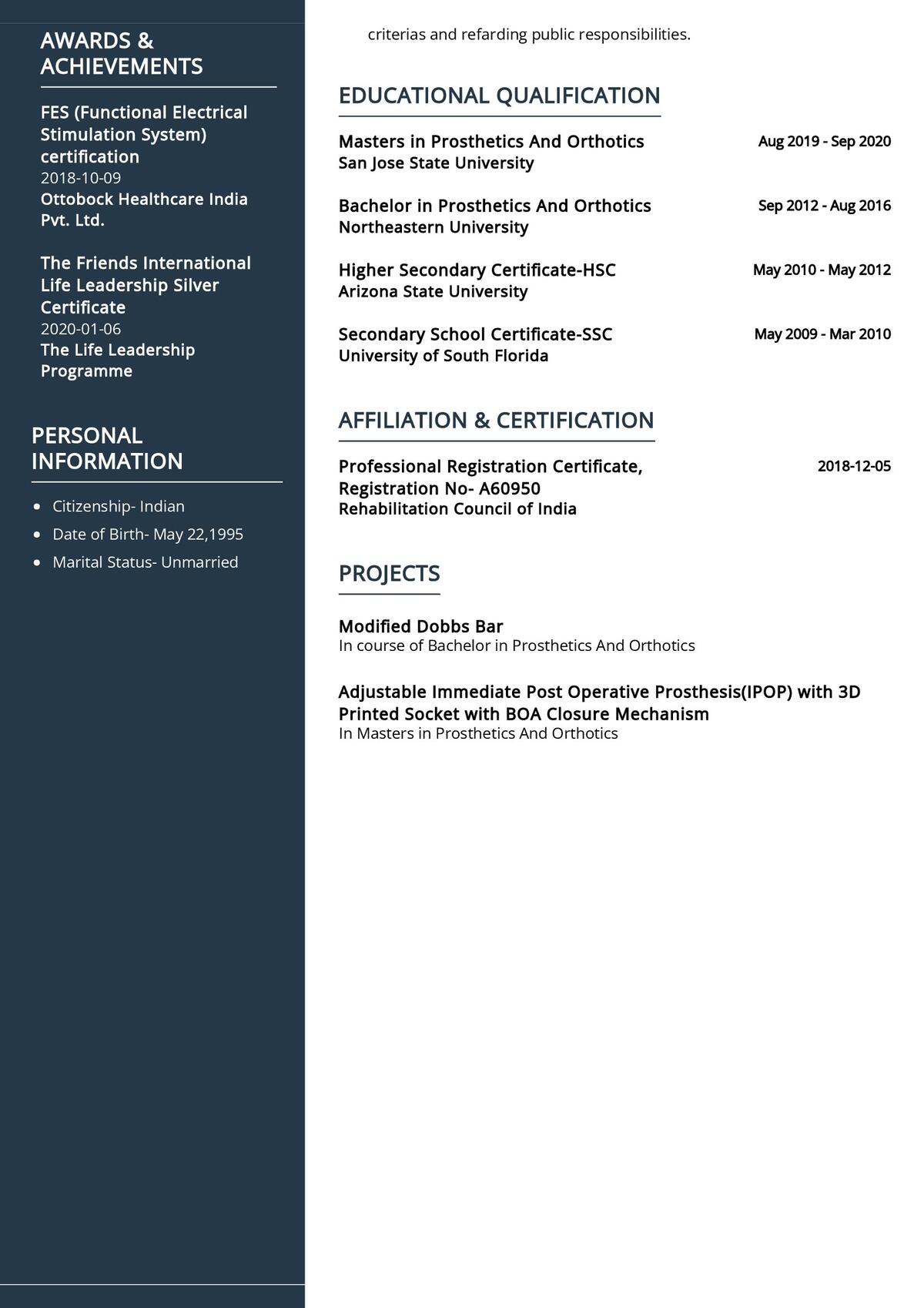What Should Be Included In A Certified Prosthetist & Orthotist Resume?
A Certified Prosthetist & Orthotist resume should be comprehensive and clearly demonstrate an understanding of the clinical and technical aspects of the field. It should also demonstrate the applicant’s ability to effectively communicate and collaborate with patients, families, and healthcare teams. The following are key elements that should be included in a Certified Prosthetist & Orthotist resume:
- Education and certifications: Make sure to include the name, location, and dates for any degrees and certifications you’ve earned.
- Professional experience: Include a list of the organizations you worked with, the position you held, and any honors or awards you received while employed with them.
- Technical skills: Highlight any technical skills that you possess, such as experience working with medical equipment, software, and CAD/CAM systems.
- Patient care and communication: Demonstrate your ability to work with patients and family members by providing examples of successful patient/family communication, problem-solving, and successful outcomes.
- Professional development and community involvement: Show employers that you are committed to the profession and the community by highlighting any professional societies you are a member of and any volunteer positions you held.
For those who are just starting out, a resume should also include a list of relevant courses and any relevant laboratory and clinical experiences. Additionally, you should include any clinical rotations, internships, and/or research projects that you have participated in.
By highlighting your education, experience, skills, and community involvement, you will be able to demonstrate your commitment to the field and your readiness to take on the challenges of a Certified Prosthetist & Orthotist position . Additionally, showcasing your communication and problem-solving skills will show employers that you are capable of building strong relationships with patients and colleagues, which are key to achieving positive and successful outcomes.
What Skills Should I Put On My Resume For Certified Prosthetist & Orthotist?
As a Certified Prosthetist & Orthotist, your resume needs to demonstrate your specialized capabilities in the field of prosthetics and orthotics. It’s important to showcase the skills and abilities that are specific to the job and highlight your knowledge of technology, patient care, and product knowledge.
When creating your resume, make sure to list any relevant certifications, such as the American Board of Prosthetics and Orthotics (ABPO). Additionally, include any technical skills required to successfully fabricate, fit, or adjust prosthetics and orthotics, as well as any experience working in the field.
In terms of soft skills, emphasize any patient care experience you have, as well as the ability to effectively communicate and collaborate with members of the healthcare team. Additionally, highlight any experience you have with customer service, as this is important for interacting with patients and families.
Finally, be sure to showcase your knowledge of prosthetics and orthotics materials and products. This includes any experience you have in the selection and sizing of components, as well as your ability to install and maintain orthotic and prosthetic devices.
By carefully selecting the skills and abilities that relate to the Certified Prosthetist & Orthotist position, you can create a resume that stands out to potential employers and highlights your unique qualifications.
What Is The Job Description Of The Certified Prosthetist & Orthotist?
A Certified Prosthetist & Orthotist (CPO) is a highly specialized medical professional who specializes in designing, constructing, and fitting prostheses and orthoses. Prostheses are artificial components used to replace missing limbs or body parts, while orthoses are braces that are used to support weakened or damaged body parts. CPOs are often certified by the American Board for Certification in Prosthetics and Orthotics (ABCPO).
CPOs provide a variety of services which include consulting with patients to determine their needs, fitting patients for appropriate prostheses and orthoses, evaluating and managing the use of prostheses and orthoses, and providing patient education and support. They also provide comprehensive follow up care for patients wearing prosthetics or orthotics. CPOs must have excellent communication skills, be detail-oriented, and have a thorough knowledge of anatomy and biomechanics.
It’s important for a CPO to be aware of the most current technologies, materials, and techniques used in the field. Through continuing education and training, CPOs are able to stay current on new advancements and be more effective in their work.
To be certified as a CPO, candidates must pass both a written and a practical exam. The written exam is a comprehensive assessment of the candidate’s knowledge of anatomy, biomechanics, orthotics, and prosthetics. The practical exam includes hands-on skills such as measuring, sculpting, and fitting a patient.
Candidates must also have completed at least two years of formal, full-time training in an ACLP-accredited prosthetics and orthotics program. After completing the certification exam, CPOs must keep their certification current with continuing education and training.
What Is A Good Objective For A Certified Prosthetist & Orthotist Resume?
When writing a resume for a Certified Prosthetist & Orthotist, it is important to include a good objective. An objective should summarize your professional qualifications and career goals. It should be written in a way that demonstrates to potential employers why you would be a great candidate for the position.
A well-written objective should begin by stating your experience and credentials as a Certified Prosthetist & Orthotist. Provide details about the types of prostheses and orthotics you have worked with, as well as any other related skills that would make you well-suited for the job. Mention your desire to work with a team of experts, and demonstrate your determination to succeed.
The next section should include your career goals for the position. This can include a desire to help patients regain their mobility, or to become a leader in the field of prosthetics and orthotics. Make sure to emphasize your commitment to using the latest technology and techniques, as well as your ability to think critically and create innovative solutions.
Finally, highlight any other skills or qualifications that could be beneficial to the employer. Include any specialized knowledge or certifications that you may have, such as advanced training or continuing education. You can also include any other relevant experience that could be seen as an asset, such as any volunteer work or research projects you have participated in.
By providing a comprehensive yet concise objective, you can ensure that employers are able to quickly identify your qualifications and understand why you would be the best person for the job.
What Are The Career Prospects In The Certified Prosthetist & Orthotist?
A Certified Prosthetist & Orthotist (CPO) is a highly specialized medical professional who designs, manufactures, fits, and services prosthetic and orthotic devices. This career path offers excellent career prospects for those looking to make a real difference in the lives of patients. Prosthetic and orthotic devices are used to help people with physical disabilities or impairments to move, function, and live more independently.
CPOs are responsible for assessing a patient’s medical needs, prescribing solutions, and making sure that the devices are fitted correctly and safely. They must also have strong communication and interpersonal skills to work effectively with a variety of medical professionals and patients.
CPOs must have a Bachelor’s Degree in Prosthetics and Orthotics or a related field. Additionally, they must be licensed by the Board of Certification in Prosthetics & Orthotics. Many states also require CPOs to become certified in Basic Life Support (BLS).
The demand for CPOs is expected to continue to grow as more people live longer and require prosthetic and orthotic devices. With the right qualifications and experience, CPOs can expect to earn a lucrative salary and enjoy job stability and security. Those who work in this field can also feel proud knowing that they are helping their patients lead more independent and fulfilling lives.
Key Takeaways for an Certified Prosthetist & Orthotist resume
When constructing a resume for a Certified Prosthetist & Orthotist (CPO), it is important to highlight the unique skills, experiences, and qualifications that make you well-suited for the position. As the CPO is responsible for the design, fitting, and evaluating of prostheses, orthoses, and other assistive device, it is essential to emphasize any formal training or certifications and relevant experience you have in the field.
In addition to highlighting your professional qualifications, you should also include any volunteer or educational experience that is related to the CPO profession. This can include any voluntary work you have done in prosthetics or orthotics, or any research or clinical experience you have acquired. By showcasing your successes in the field, you will demonstrate your commitment to the profession and show potential employers that you have the necessary skills to perform the job.
Furthermore, it is important to demonstrate your familiarity with the CPO profession through the use of industry-specific terminology. You should include any relevant terminology that you have learned through your CPO studies, as this will demonstrate your understanding of the profession and impress potential employers. It is also important to list any relevant certifications or licenses that you hold, as this will show that you are qualified for the position.
Lastly, it is essential to showcase any awards or recognition you have received for your work in the field. By showcasing your achievements, you will show potential employers that you are a top candidate for the role, and that you have the drive and commitment to succeed in the profession.



